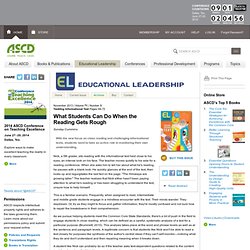

Tackling Informational Text:What Students Can Do When the Reading Gets Rough. Nick, a 5th grader, sits reading with the informational text held close to his eyes, an intense look on his face.

The teacher moves quietly to his side for a reading conference. When she asks him to tell her about what he's reading, he pauses with a blank look. He quickly glances at the end of the text, then looks up and regurgitates the last fact on the page: "The Himalaya are growing taller. " The teacher realizes that Nick either hasn't been paying attention to what he's reading or has been struggling to understand the text, unsure how to help himself. This is a familiar scenario. As we pursue helping students meet the Common Core State Standards, there's a lot of push in the field to engage students in close reading, which can be defined as a careful, systematic analysis of a text for a particular purpose (Brummett, 2010). A student like Nick can probably do so if the teacher asks text-dependent questions related to the content (and there's a place for this).
Collision! Tackling Informational Text:Points of Entry. We'll just drive over here now so we don't drop down into that ice crevasse.

There's moving water just below the surface. " We looked at each other in silent horror. What had started as a fun adventure onto an Icelandic glacier suddenly seemed more risky. Our guide's words were meant to soothe us, but neither of us felt confident. Fortunately, we had a seasoned explorer to lead us, one who understood the terrain. As teachers, we also lead our students through the challenging terrain of informational texts. In other words, we don't simply expect our students to hurtle themselves headlong into a piece of complex informational text alone. What Makes Informational Texts So Challenging? For the purposes of this article, we define informational text as text that teaches about the physical, biological, or social world.
Because water molecules cling to each other like tiny magnets, a drop of water can stay in one piece, even as it falls through the air. Access Point 1: Establishing Purpose. Note-Taking with iPads. I vividly remember how I first learned to take notes.

My sixth grade geography teacher lectured in outline style: "Roman Numeral one - China. A - Qin Dynasty. 1 - Rulers . . . " We wrote down precisely what he said, and to this day, I still take notes in outline form. However, consider Sunni Brown's TED Talk, "Doodlers Unite. " She argues that engaging in sketching while listening to complex ideas further supports learning. While outlining may work for me, what about those who value taking notes in the margins? When students learn to hand-write their notes, they focus on content and organization within a single medium -- paper. Cameras and Microphones One of the most valuable features of iPad to support note-taking may be the camera. In addition to incorporating photos, many note-taking apps also include audio recording.
Typing and Drawing We experienced an influx of "laptop kids" in our middle school. With iPad, these same students could both type and draw their notes. Internet Sources Reliability. Determining Importance.